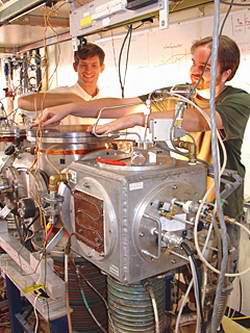Science Fiction
Dictionary
A B C D E F G H I J K L M N O P Q R S T U V W X Y Z
Lower Limit For Nanobot Size Discovered

Size limits for nanotechnology devices have finally been determined by University of Arizona physicists, who have succeeded in directly measuring how close an atom can come to a surface before its wave changes. This is the first time that the idea that a fast-moving atom's wave shortens and lengthens, depending on its distance from a surface. This idea was first proposed in the late 1920's.
This measurement is essential information for nanotechnologists, because it limits how small a device can be before van der Waals forces between atoms and surfaces starts to become a problem for a working device.

(From Atom interferometer)
UA optical sciences doctoral candidate John D. Perreault and UA assistant professor of physics Alexander D. Cronin used a sophisticated device called an atom interferometer in making the measurement. "Our research provides the first direct experimental evidence that a surface 25 nanometers away (25 billionths of a meter) causes a shift in the atom wave crests," Perreault said. "It shows that the van der Waals interaction may be a small scale force, but it's a big deal for atoms." Perreault and Cronin found that atoms closer than 25 nanometers to a surface are very strongly attracted to the surface because of the van der Waals interaction-- so strongly that the atoms are accelerated with the force of a million g's.
This new research causes an interesting dilemma not just for researchers in nanotechnology, but for science fiction writers as well, because it sets limits on imagination. When Einstein's work on relativistic physics became well established, sf writers were hard put to create believable space travel that involved accelerating a mass (like a spaceship) anywhere close to the speed of light, let alone at multiples of light speed. The arguments over whether hyperspace jumps and supralight drives are possible, or whether we will wind up using slowboats to journey to the stars, have gone on for several generations now.
When Philip K. Dick imagined the autofac in 1955 (and embryonic robots ten years later), there were no limits to how small you could imagine a nanobot to be:
The bits were in motion. Microscopic machinery, smaller than ants, smaller than pins, working energetically, purposefully - constructing something that looked like a tiny rectangle of steel."They're building," O'Neill said, awed.
(Read more about Philip K. Dick's autofac)
Dick's literary efforts preceded Richard Feynman's famous 1959 talk that kicked off the scientific pursuit of nanotechnology.
Read more here
Scroll down for more stories in the same category. (Story submitted 9/25/2005)
Follow this kind of news @Technovelgy.| Email | RSS | Blog It | Stumble | del.icio.us | Digg | Reddit |
Would
you like to contribute a story tip?
It's easy:
Get the URL of the story, and the related sf author, and add
it here.
Comment/Join discussion ( 3 )
Related News Stories - (" Engineering ")
The Zapata Air Scooter Would Be Great In A Science Fiction Story
'Betty's slapdash style.'
Could Crystal Batteries Generate Power For Centuries?
'Power could be compressed thus into an inch-square cube of what looked like blue-white ice' - Edmond Hamilton, 1940.
Replace The Smartphone With A Connected Edge Node For AI Inference
'Buy a Little Dingbat... electropen, wrist watch, pocketphone, pocket radio, billfold ... all in one.' - Raymond F. Jones, 1945.
Sunday Robotics 'Memo' Bot Has Unique Training Glove
'He then started hand movements of definite pattern...' - Robert Heinlein, 1942
Technovelgy (that's tech-novel-gee!) is devoted to the creative science inventions and ideas of sf authors. Look for the Invention Category that interests you, the Glossary, the Invention Timeline, or see what's New.
Science Fiction
Timeline
1600-1899
1900-1939
1940's 1950's
1960's 1970's
1980's 1990's
2000's 2010's
Current News
The Zapata Air Scooter Would Be Great In A Science Fiction Story
'Betty's slapdash style.'
Thermostabilized Wet Meat Product (NASA Prototype)
There are no orbiting Michelin stars. Yet.
Could Crystal Batteries Generate Power For Centuries?
'Power could be compressed thus into an inch-square cube of what looked like blue-white ice'
India Ponders Always-On Smartphone Location Tracking
'It is necessary... for your own protection.'
Amazon Will Send You Heinlein's Knockdown Cabin
'It's so light that you can set it up in five minutes by yourself...'
Is It Time To Forbid Human Driving?
'Heavy penalties... were to be applied to any one found driving manually-controlled machines.'
Replace The Smartphone With A Connected Edge Node For AI Inference
'Buy a Little Dingbat... electropen, wrist watch, pocketphone, pocket radio, billfold ... all in one.'
Artificial Skin For Robots Is Coming Right Along
'... an elastic, tinted material that had all the feel and appearance of human flesh and epidermis.'
Robot Guard Dog On Duty
I might also be thinking of K-9 from Doctor Who.
Wearable Artificial Fabric Muscles
'It is remarkable that the long leverages of their machines are in most cases actuated by a sort of sham musculature...'
BrainBridge Concept Transplant Of Human Head Proposed
'Briquet’s head seemed to think that to find and attach a new body to her head was as easy as to fit and sew a new dress.'
Google's Nano Banana Pro Presents Handwritten Math Solutions
'...copy was turned out in a charming and entirely feminine handwriting.'
Edible Meat-Like Fungus Like Barbara Hambly's Slunch?
'It was almost unheard of for slunch to spread that fast...'
Sunday Robotics 'Memo' Bot Has Unique Training Glove
'He then started hand movements of definite pattern...'
Woman Marries Computer, Vonnegut's Dream Comes True
'Men are made of protoplasm... Lasts forever.'
Natural Gait With Prosthetic Connected To Nervous System
'The leg was to function, in a way, as a servo-mechanism operated by Larry’s brain...'
